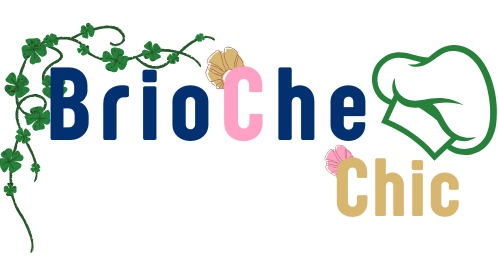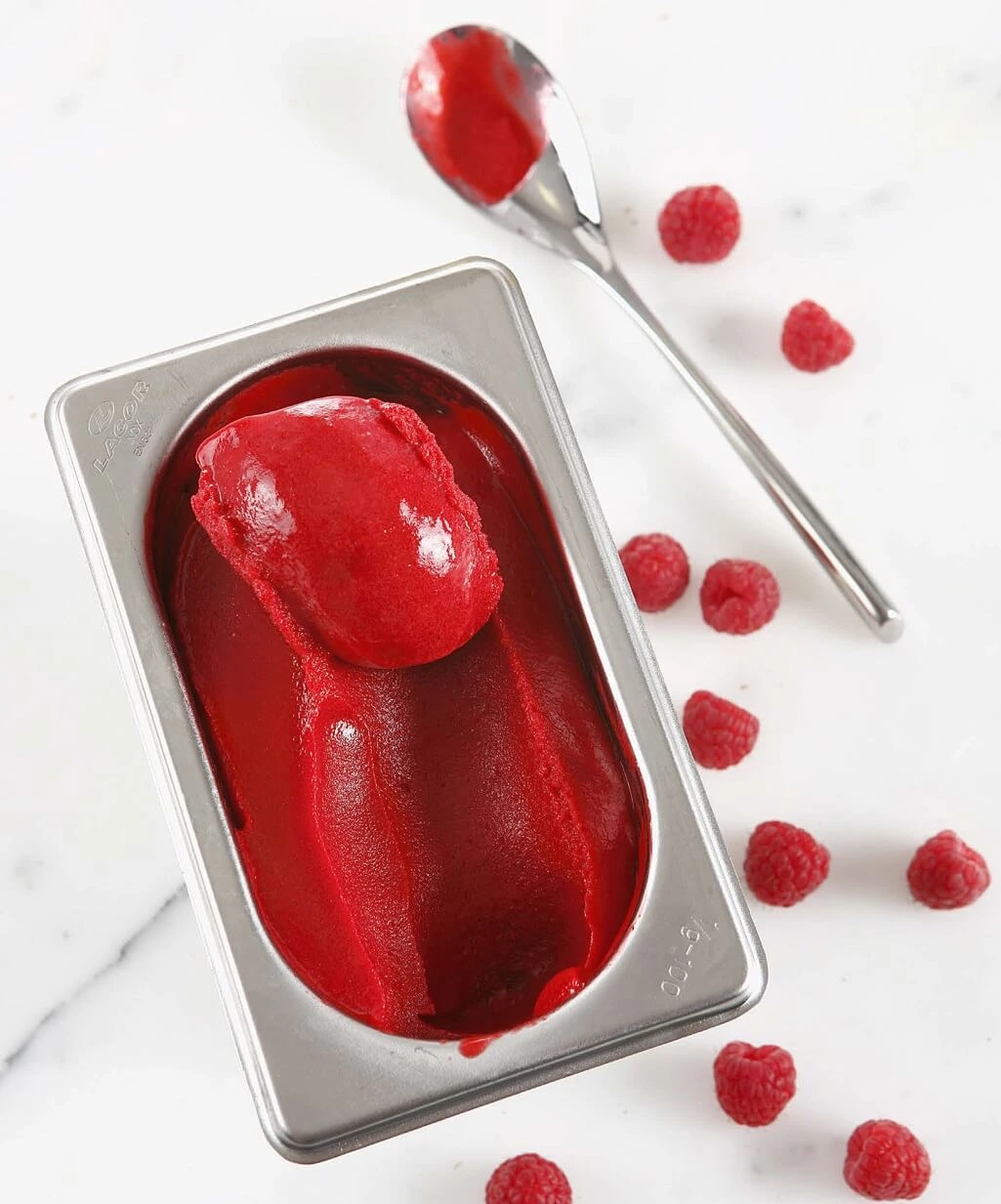Frozen Raspberry Sorbet
In the world of frozen desserts, few creations capture the essence of summer’s vibrancy quite like a full-fruit raspberry sorbet.
This exquisite dessert is a masterclass in simplicity and purity, where the natural brilliance of sun-kissed raspberries takes center stage.
Every spoonful is a burst of vivid color and intense flavor, showcasing the true character of the fruit in its most unadulterated form.
Unlike traditional ice creams or custard-based treats, raspberry sorbet eschews heaviness and creaminess, opting instead for a delicate balance between tartness and sweetness.
The result is a refreshing, light, and palate-cleansing dessert that revitalizes the senses and leaves a lingering impression of freshness.
It’s the kind of treat that speaks directly to the soul of the fruit lover, offering an invigorating escape into nature’s bounty.
The creation of a flawless raspberry sorbet is an intricate dance of craftsmanship and patience.
The journey begins with the careful selection of the ripest, most fragrant raspberries, harvested at the peak of their season.
These berries, bursting with juice and vibrant aroma, provide the foundation for the sorbet’s rich and complex flavor profile.
The fruit is gently transformed through processes designed to preserve its vivid color, delicate seeds, and aromatic qualities —
all while enhancing the smooth, velvety texture that defines an exceptional sorbet.
Crafting the sorbet demands attention
to detail in balancing natural sweetness without overshadowing the berries’ bright acidity.
This equilibrium is essential, as it allows the raspberry’s nuanced flavors — the floral hints, the subtle tartness, and the underlying sweetness —
to shine through with clarity and depth. The process involves skillful pureeing, straining to achieve a silky smoothness,
and precise chilling techniques to create the perfect consistency that is neither icy nor overly dense.
This sorbet is much more than a frozen dessert; it’s an elegant sensory experience.
Its translucent ruby hue captivates the eye, promising the vibrant flavor to come. Upon tasting,
the sorbet offers a refreshing, cooling sensation that awakens the palate. Its clean, crisp finish makes it an ideal companion to heavier dishes as a palate cleanser, or a delightful finale to any meal.
Serving full-fruit raspberry sorbet is an opportunity to celebrate its natural beauty.
It pairs beautifully with delicate herbs like mint or basil, fresh berries, or a drizzle of sparkling wine for added sparkle and sophistication.
Its versatility makes it equally suited to casual summer gatherings or refined dinner parties, appealing to guests who appreciate authenticity and refined flavors.
Ultimately, the full-fruit raspberry sorbet embodies the philosophy that the finest desserts are those that honor the ingredients and the seasons.
It is a tribute to the raspberry’s fleeting glory, captured in a frozen form that allows us to savor its essence long after the harvest season ends.
This sorbet invites you to slow down, indulge in nature’s simplest pleasures, and experience a moment of pure, vibrant delight.
Raspberry Sorbet for 6 to 8 People
Preparation & Timing
- Preparation time: Approximately 30 minutes
(This includes blending the fruit, preparing the sugar syrup, and mixing everything together.) - Maturation time: 2 hours
(Allowing the sorbet mixture to rest and develop deeper flavors before freezing.) - Storage: Up to 1 week
(Keep refrigerated or frozen in an airtight container to maintain freshness.)
Equipment Needed
- Candy thermometer:
Essential for monitoring the temperature of the sugar syrup to ensure perfect texture and sweetness balance. - Immersion blender (hand blender):
Used for smoothly blending the raspberry pulp and sugar mixture to achieve a fine, even consistency. - Ice cream machine (sorbet maker/turbine):
To churn the sorbet mixture, incorporating air and preventing large ice crystals for a creamy texture. - Freezer container:
For storing the finished sorbet during freezing or after churning to maintain its texture and flavor.
Ingredients
- 75 g sucrose (table sugar)
- 8 g dextrose
- 17 g glucose powder (atomized glucose)
- 100 g water
- 667 g fresh raspberry pulp
- 33 g fresh lemon juice (yellow lemon)
Preparation Method
- In a bowl, combine the sucrose, dextrose, and glucose powders.
- In a saucepan, heat the water. When it reaches about 40 °C (104 °F), add the sugar mixture and bring to a boil.
- Once boiling, remove from heat and cool quickly in the refrigerator.
- Add the raspberry pulp and fresh lemon juice to the cooled syrup, then blend thoroughly with an immersion blender until smooth.
- Let the mixture mature in the refrigerator for at least 2 hours.
- This resting period allows the flavors to develop fully.
- After maturation, blend the mixture again to ensure a perfectly smooth texture before pouring it into the ice cream machine (turbine).
- Follow the manufacturer’s instructions for churning.
- Once churned, transfer the sorbet into a freezer-safe container and freeze rapidly at −35 °C (−31 °F) to set the texture.
- Store the sorbet at −20 °C (−4 °F) until ready to serve, ensuring it maintains optimal freshness and creaminess.
Conclusion: A Sorbet That Captures the Soul of the Raspberry
Crafting a full-fruit raspberry sorbet is not just about following a recipe —
it’s about preserving the integrity of a fleeting seasonal treasure and transforming it into a refined, frozen expression of nature’s vibrancy.
With its brilliant ruby hue, delicate acidity, and lush, pure flavor, this sorbet speaks directly to the senses.
Each spoonful offers a clean, refreshing pause — light yet impactful, simple yet complex — embodying the essence of the raspberry in its most honest form.
The meticulous process of creating this sorbet — from balancing sugars for texture and stability, to respecting the natural fragrance and taste of the fruit —
is what elevates it from a mere dessert to a gastronomic experience. It demands precision,
patience, and a certain reverence for the raw ingredient, which rewards the maker with a dessert that is as beautiful as it is delicious.
Whether
served alone in a chilled coupe, paired with a shortbread biscuit, or used as a bright counterpoint to a richer chocolate or almond-based dessert,
this raspberry sorbet brings freshness and finesse to any table. It is as at home in a garden picnic as it is in a Michelin-starred tasting menu, showcasing its extraordinary versatility.
Ultimately, this sorbet invites us to pause and savor —
to slow down and appreciate the natural brilliance of one simple fruit, treated with care and transformed with elegance.
It’s more than a dessert. It’s a celebration of flavor, of color, of seasonality — and of everything that makes fruit-forward pastry a timeless art.How to Use Egg Whites in Frozen Desserts
ihttp://How alcohol affects freezing in sorbet – Serious Eats
Frequently Asked Questions About Raspberry Sorbet
Q: What makes this raspberry sorbet “full fruit”?
A:
The term “full-fruit” refers to the high concentration of real raspberry pulp used in the sorbet base. Unlike artificially flavored or watered-down versions, this sorbet is made primarily with real raspberries
— fresh or frozen — that have been gently processed to preserve their natural color, flavor, and texture.
The result is a sorbet that is intensely fruity, vividly colored, and authentically flavored, without relying on extracts or synthetic aromas.
It’s fruit-forward in the purest sense, with raspberries making up the majority of the composition.
Q: Why use multiple types of sugar like sucrose, dextrose, and glucose?
A:
Each sugar serves a specific function in sorbet making.
Sucrose (common table sugar) provides sweetness, but too much of it can result in an overly sweet or icy texture.
Dextrose has less sweetening power but lowers the freezing point, which helps maintain a softer, scoopable texture. Glucose (especially atomized glucose)
adds body and stabilizes the mix, improving mouthfeel and limiting crystallization.
The careful balance of these sugars ensures a silky sorbet that’s flavorful, smooth, and easy to serve straight from the freezer.
Q: What is the purpose of the maturation period?
A:
Allowing the sorbet base to rest — usually for at least 2 hours in the refrigerator
— is known as maturation. During this time, the sugars and fruit purée fully integrate, the texture stabilizes, and the flavor deepens.
Maturation also helps air incorporate more evenly during churning, leading to a smoother sorbet.
Skipping this step may result in a sorbet that’s less stable, less creamy, and lacking that beautifully intense fruit character.
Q: Can I make this sorbet without a professional ice cream machine?
A:
Yes — but the texture will differ. A turbine or ice cream maker is ideal for achieving a smooth, airy result, as it simultaneously freezes and churns the mixture to break up ice crystals.
If you don’t have one, you can pour the matured base into a shallow tray, freeze it partially, then whisk or blend it vigorously every 30–45 minutes for a few hours until it becomes scoopable.
It’s a bit more effort, but the flavor will still shine.
Q: How can I enhance or customize this sorbet?
A:
This raspberry sorbet is wonderfully versatile.
You can infuse the syrup with fresh mint, basil, or lemon verbena before combining it with the fruit, for an herbaceous twist.
A splash of raspberry eau-de-vie or a spoonful of Chambord liqueur can add depth and elegance.
For a gourmet presentation, serve it alongside a dark chocolate tuile, or layer it in a coupe glass with fresh berries and a dollop of whipped mascarpone.
The sorbet’s clean profile pairs beautifully with both sweet and sharp contrasts.
Q: How should it be stored, and for how long?
A:
After churning, the sorbet should be frozen quickly at −35 °C (if possible) to preserve its texture, and then stored at −20 °C in a well-sealed ice cream container.
Properly stored, it will retain optimal flavor and texture for about one week.
Although it may remain safe longer, the fruit flavor can begin to dull, and ice crystals may form over time.
Always press a piece of parchment or plastic wrap directly onto the surface before closing the lid to minimize freezer burn.

